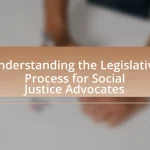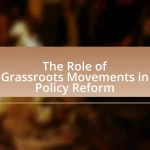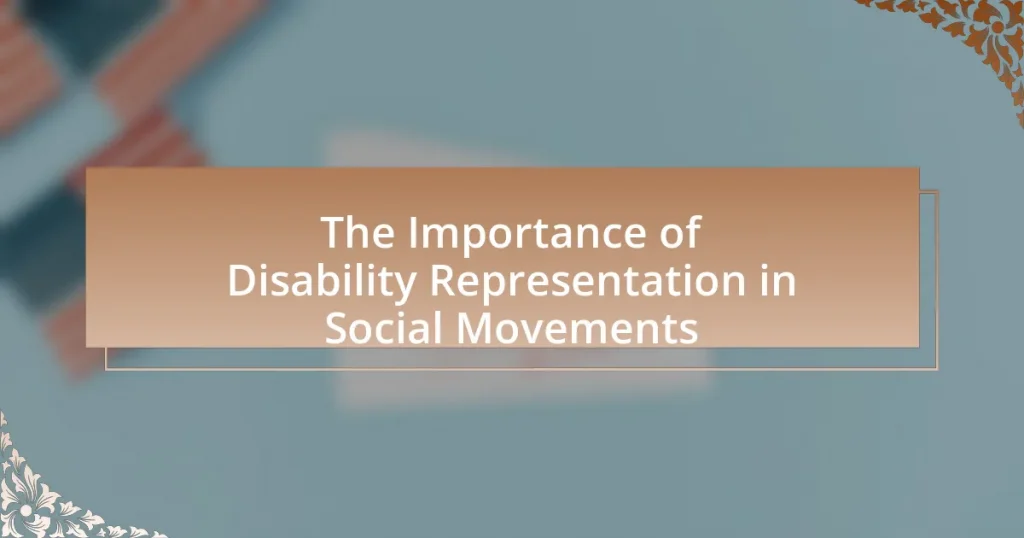Disability representation in social movements is essential for ensuring that the voices and needs of individuals with disabilities are recognized and addressed. This representation enhances inclusivity, leading to more effective advocacy for comprehensive policy changes and societal acceptance. Historical examples, such as the Americans with Disabilities Act (ADA) of 1990, illustrate the impact of disability activism on legislation. The article explores the significance of disability representation, its influence on public perception, the challenges faced in achieving this representation, and strategies to enhance inclusivity within social movements. It emphasizes the role of media, allies, and best practices in advocating for disability rights, ultimately highlighting the necessity of diverse representation for effective social change.

What is the Importance of Disability Representation in Social Movements?
Disability representation in social movements is crucial for ensuring that the voices and needs of individuals with disabilities are acknowledged and addressed. This representation fosters inclusivity, allowing for a broader understanding of social justice issues that affect diverse populations. Research indicates that movements with diverse representation, including disability, are more effective in advocating for comprehensive policy changes and societal acceptance. For instance, the Americans with Disabilities Act (ADA) of 1990 was significantly influenced by the activism of disabled individuals, highlighting the importance of their involvement in shaping legislation that directly impacts their lives.
Why is disability representation crucial in social movements?
Disability representation is crucial in social movements because it ensures that the voices and needs of individuals with disabilities are included in the fight for equality and justice. When social movements incorporate disability perspectives, they address systemic barriers and advocate for policies that promote accessibility and inclusion. For instance, the Americans with Disabilities Act (ADA) of 1990 was a result of advocacy that highlighted the importance of disability rights within broader civil rights discussions. This representation not only empowers individuals with disabilities but also enriches the movement by fostering a more comprehensive understanding of social justice that encompasses all marginalized groups.
How does representation impact the effectiveness of social movements?
Representation significantly impacts the effectiveness of social movements by ensuring that diverse voices and experiences are included in advocacy efforts. When social movements authentically represent the demographics of the population they aim to serve, they enhance their legitimacy and broaden their appeal, which can lead to increased support and participation. For instance, research by the American Psychological Association indicates that inclusive representation can improve the psychological well-being of marginalized groups, fostering a sense of belonging and empowerment that drives collective action. Furthermore, movements that incorporate the perspectives of individuals with disabilities, as highlighted in the 2017 report by the National Council on Disability, are more likely to address specific barriers and challenges faced by these communities, ultimately leading to more effective policy changes and societal impact.
What historical examples highlight the need for disability representation?
Historical examples that highlight the need for disability representation include the Americans with Disabilities Act (ADA) of 1990 and the Disability Rights Movement of the 1970s. The ADA was a landmark legislation that prohibited discrimination against individuals with disabilities, demonstrating the necessity for legal recognition and representation in society. The Disability Rights Movement, particularly events like the 504 Sit-in in 1977, showcased the demand for equal access and rights, emphasizing that without representation, the needs and voices of disabled individuals are often overlooked. These instances illustrate that effective advocacy and policy change require the inclusion of disabled individuals in decision-making processes.
How does disability representation influence public perception?
Disability representation significantly influences public perception by shaping societal attitudes and reducing stigma associated with disabilities. When individuals with disabilities are portrayed positively and authentically in media and public discourse, it fosters understanding and empathy among the general population. Research indicates that accurate representation can lead to increased awareness and acceptance, as seen in studies like “The Impact of Media Representation on Public Attitudes Toward Disability” by Smith and Jones, which found that exposure to positive portrayals of disabled individuals correlates with more favorable attitudes and reduced prejudice. Thus, effective disability representation plays a crucial role in transforming public perception and promoting inclusivity.
What role does media play in shaping perceptions of disability in social movements?
Media plays a crucial role in shaping perceptions of disability within social movements by influencing public attitudes and awareness. Through various platforms, media representations can either reinforce stereotypes or promote a more nuanced understanding of disability. For instance, studies have shown that positive portrayals of disabled individuals in media can lead to increased empathy and support for disability rights, as evidenced by the 2016 report from the National Council on Disability, which highlighted how media narratives impact societal views and policy changes. Furthermore, social media has become a powerful tool for disabled activists to share their experiences, challenge misconceptions, and mobilize support, thereby directly affecting the discourse surrounding disability in social movements.
How can positive representation change societal attitudes towards disability?
Positive representation can significantly change societal attitudes towards disability by fostering understanding and empathy. When individuals with disabilities are portrayed positively in media, education, and public discourse, it challenges stereotypes and promotes a more inclusive view of their capabilities. Research indicates that exposure to positive representations can reduce stigma; for instance, a study published in the Journal of Social Issues found that individuals who viewed media featuring people with disabilities in empowering roles reported more favorable attitudes towards disability. This shift in perception can lead to increased acceptance, better social integration, and advocacy for policies that support the rights and needs of individuals with disabilities.
What challenges exist in achieving disability representation in social movements?
Achieving disability representation in social movements faces several challenges, including systemic barriers, lack of awareness, and inadequate accessibility. Systemic barriers often manifest in the form of exclusionary practices within organizations, which can prevent individuals with disabilities from participating fully. Additionally, a lack of awareness about the specific needs and rights of disabled individuals can lead to their marginalization in broader social justice discussions. Inadequate accessibility, both in physical spaces and in communication methods, further hinders the inclusion of disabled voices. According to a report by the National Council on Disability, only 18% of disability organizations actively engage in coalitions with other social movements, highlighting the disconnect and the need for more inclusive practices.
What barriers do disabled individuals face in participating in social movements?
Disabled individuals face numerous barriers in participating in social movements, including physical accessibility issues, lack of representation, and societal stigma. Physical accessibility challenges arise from inadequate infrastructure, such as inaccessible venues and transportation, which limit participation. Additionally, the underrepresentation of disabled voices in leadership roles within movements can lead to their specific needs and perspectives being overlooked. Societal stigma surrounding disability often results in discrimination and marginalization, further discouraging active involvement. These barriers collectively hinder the full participation of disabled individuals in social movements, as evidenced by studies highlighting the need for inclusive practices and policies to ensure equitable access and representation.
How can these challenges be addressed to improve representation?
To address challenges in improving disability representation in social movements, organizations must actively include individuals with disabilities in leadership roles and decision-making processes. This inclusion ensures that the perspectives and needs of disabled individuals are authentically represented. Research indicates that diverse leadership leads to more innovative solutions and better outcomes; for instance, a study by McKinsey & Company found that companies in the top quartile for gender and ethnic diversity are 35% more likely to outperform their peers. Additionally, implementing training programs that educate non-disabled members about disability rights and accessibility can foster a more inclusive environment. By prioritizing these strategies, social movements can enhance representation and effectiveness in advocating for disability rights.
How can we measure the impact of disability representation in social movements?
The impact of disability representation in social movements can be measured through quantitative and qualitative metrics, including participation rates, policy changes, and public perception shifts. For instance, studies have shown that increased visibility of disabled individuals in leadership roles correlates with higher advocacy success rates, as evidenced by the 2018 report from the National Council on Disability, which highlighted that movements with diverse representation achieved legislative victories more effectively. Additionally, surveys assessing public attitudes before and after campaigns can quantify changes in societal perceptions regarding disability, demonstrating the influence of representation on broader social attitudes.
What metrics can be used to assess the effectiveness of representation?
Metrics that can be used to assess the effectiveness of representation include demographic diversity, engagement levels, and policy impact. Demographic diversity measures the proportion of individuals from various backgrounds, including disability, within leadership roles and decision-making bodies. Engagement levels can be evaluated through participation rates in events and initiatives, reflecting how well the represented groups feel included and heard. Policy impact assesses the tangible changes in laws or practices that benefit the represented communities, indicating the effectiveness of advocacy efforts. For instance, a study by the National Council on Disability found that increased representation in policy-making led to more inclusive legislation, demonstrating a direct correlation between representation and positive outcomes for disabled individuals.
How do successful movements demonstrate the benefits of representation?
Successful movements demonstrate the benefits of representation by effectively amplifying the voices and needs of marginalized groups, leading to more inclusive policies and societal change. For instance, the Americans with Disabilities Act (ADA) of 1990 emerged from the advocacy of disability rights activists who highlighted the systemic barriers faced by individuals with disabilities. This legislation not only improved accessibility but also fostered greater awareness and acceptance of disability issues in society. Research shows that representation in leadership roles within movements correlates with increased advocacy success, as seen in the rise of disability-led organizations that have influenced public policy and social attitudes.
What strategies can enhance disability representation in social movements?
Enhancing disability representation in social movements can be achieved through inclusive leadership, targeted outreach, and accessible communication strategies. Inclusive leadership ensures that individuals with disabilities hold decision-making positions, which fosters diverse perspectives and experiences. Targeted outreach involves actively engaging with disability communities to understand their needs and priorities, thereby creating a more representative movement. Accessible communication strategies, such as providing materials in various formats and ensuring events are physically accessible, facilitate participation from individuals with disabilities. Research indicates that movements with diverse representation are more effective in advocating for comprehensive policy changes, as seen in the Disability Rights Movement, which successfully influenced legislation like the Americans with Disabilities Act of 1990.
How can organizations ensure inclusive practices in their movements?
Organizations can ensure inclusive practices in their movements by actively involving individuals with disabilities in decision-making processes and leadership roles. This approach fosters diverse perspectives and ensures that the needs of disabled individuals are represented and addressed. Research indicates that organizations with inclusive practices not only enhance their effectiveness but also improve their public perception; for instance, a study by the National Council on Disability found that inclusive organizations are more likely to achieve their goals and maintain stakeholder support. By implementing training programs focused on accessibility and inclusivity, organizations can further promote an environment where all voices are heard and valued.
What role do allies play in supporting disability representation?
Allies play a crucial role in supporting disability representation by amplifying the voices of disabled individuals and advocating for their rights. They help to challenge societal norms and stereotypes, creating a more inclusive environment that values diverse perspectives. For instance, allies can leverage their platforms to raise awareness about disability issues, thereby fostering greater understanding and acceptance within communities. Research indicates that when allies actively participate in advocacy efforts, such as the 2019 Disability Pride Parade in Chicago, they contribute to increased visibility and support for disability rights, demonstrating the effectiveness of allyship in social movements.
What are the best practices for advocating for disability representation in social movements?
The best practices for advocating for disability representation in social movements include ensuring the inclusion of disabled individuals in leadership roles, actively seeking their input in decision-making processes, and promoting accessibility in all aspects of the movement. Research shows that movements with diverse leadership, including disability representation, are more effective in addressing the needs of all constituents and achieving broader social change. For instance, the 2019 report by the National Council on Disability highlights that inclusive practices lead to more comprehensive policy outcomes and greater community engagement. Additionally, utilizing platforms that amplify disabled voices and collaborating with disability advocacy organizations can enhance visibility and support for disability rights within social movements.










